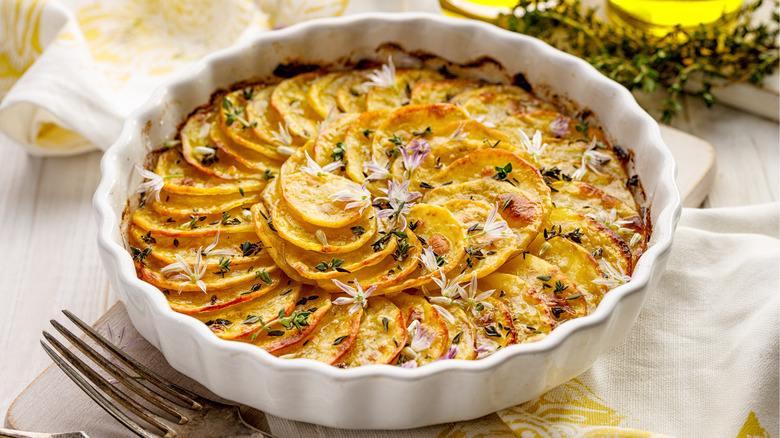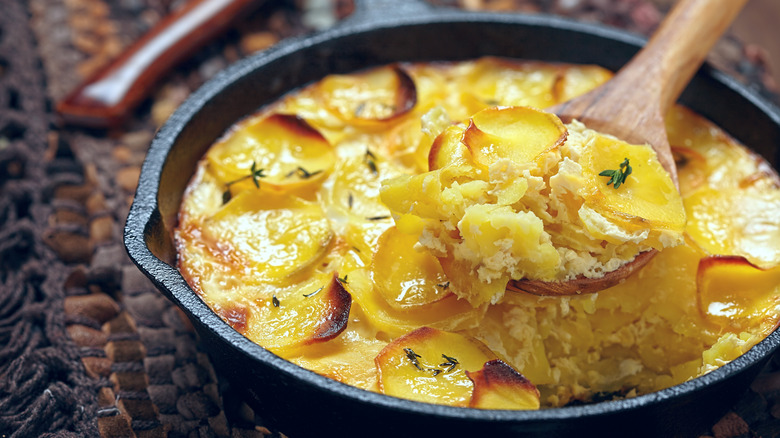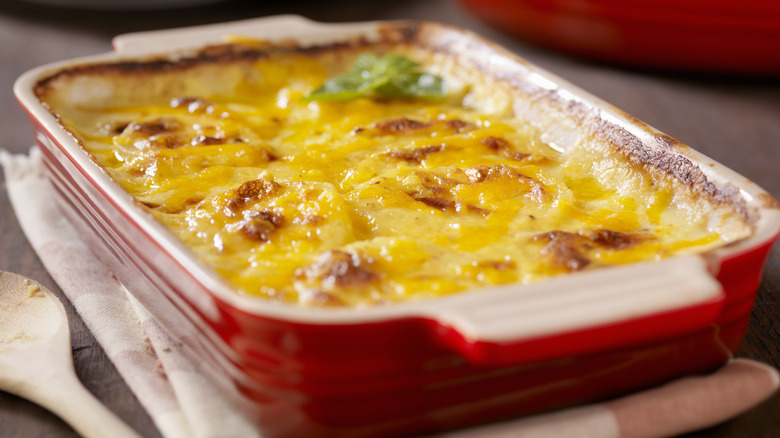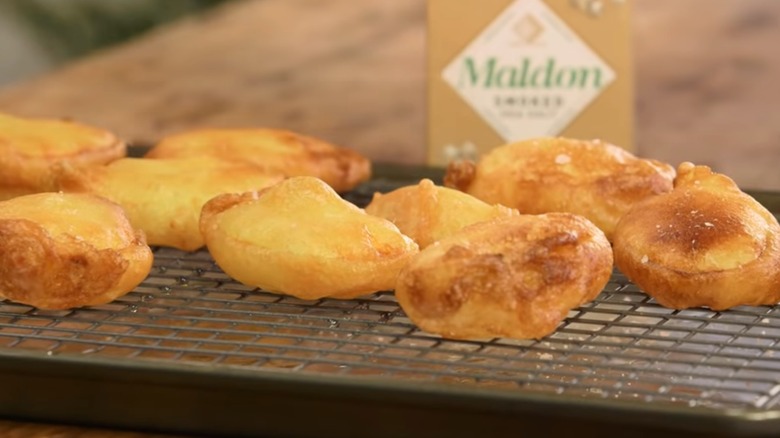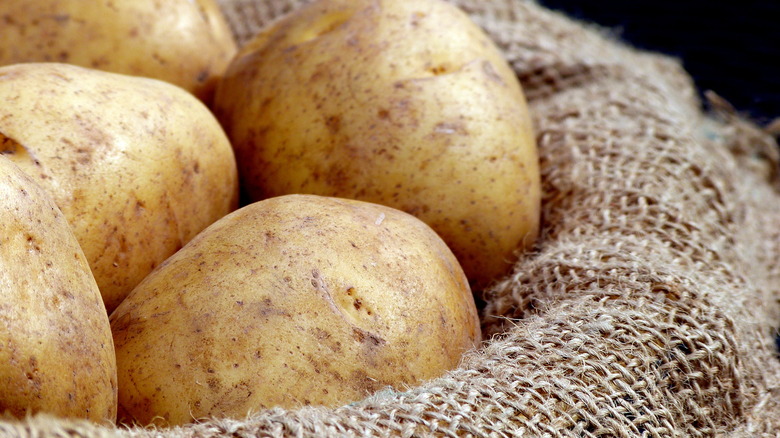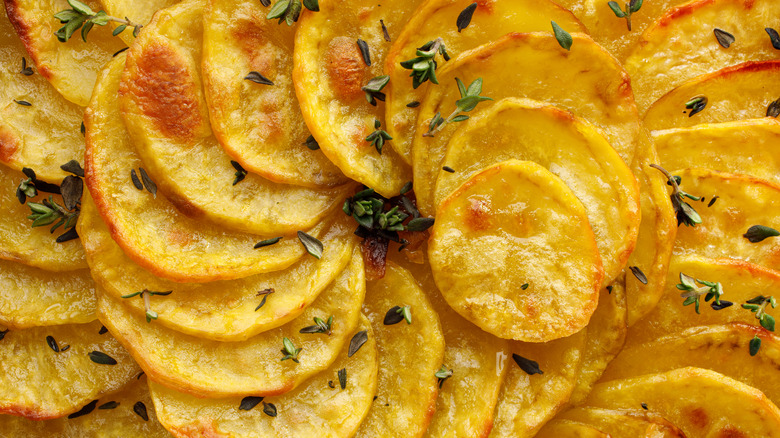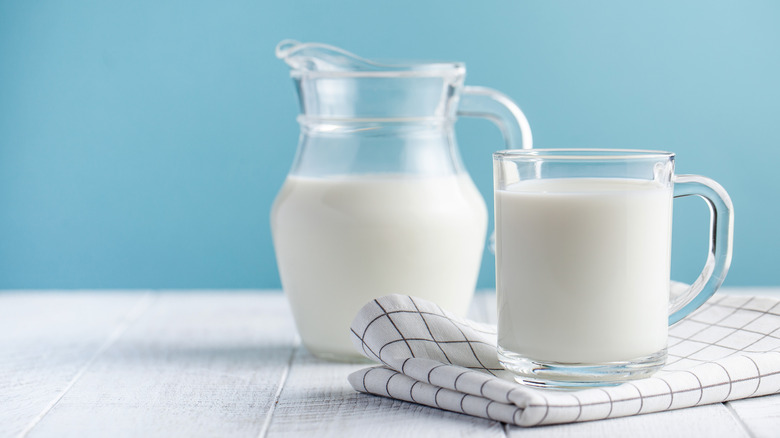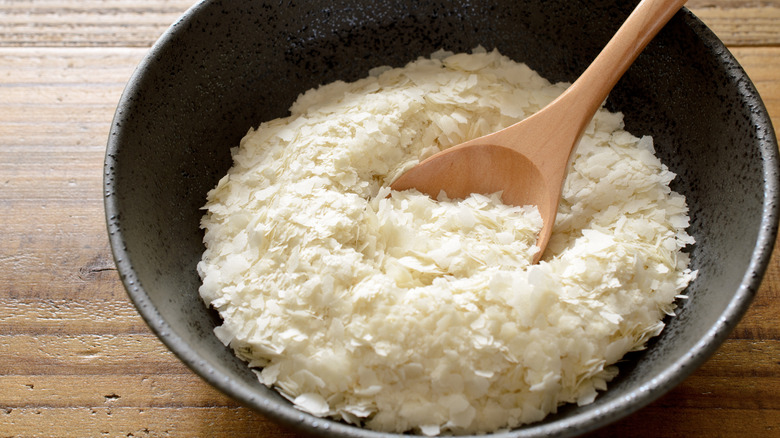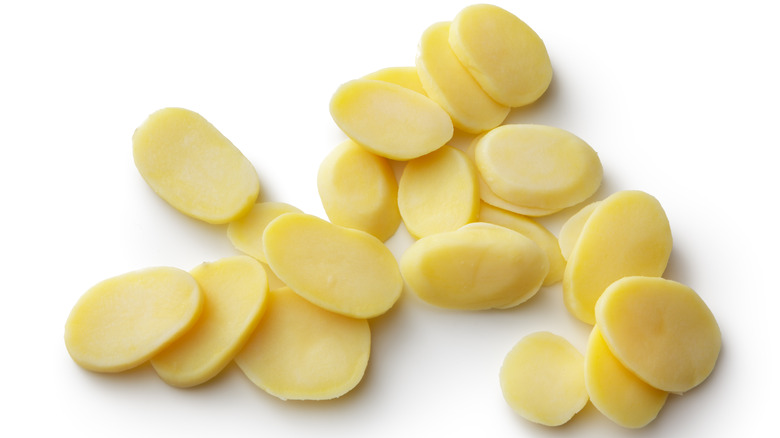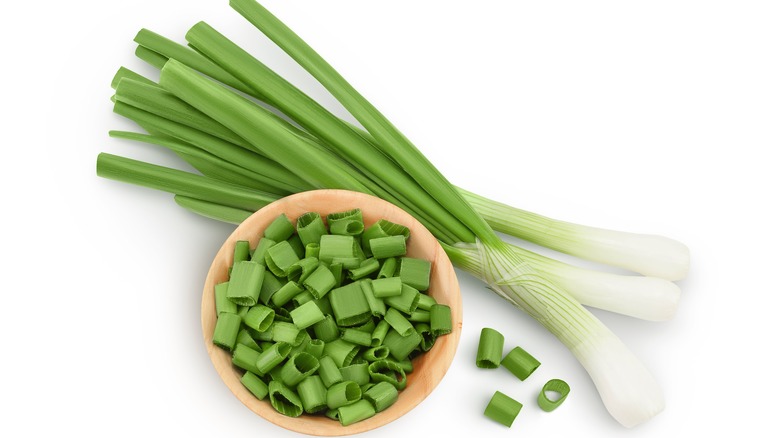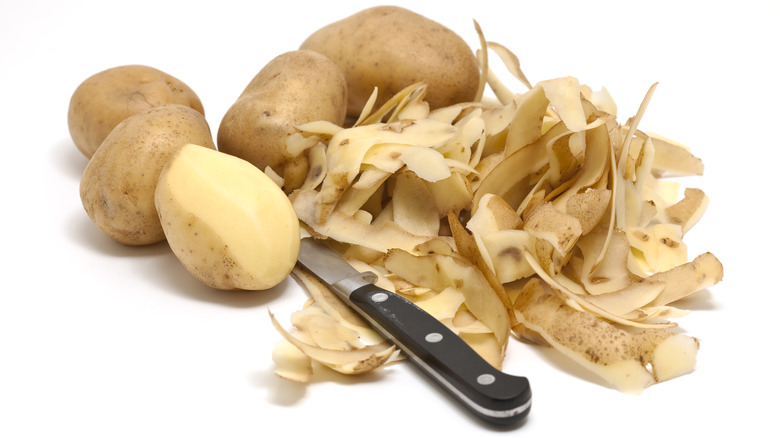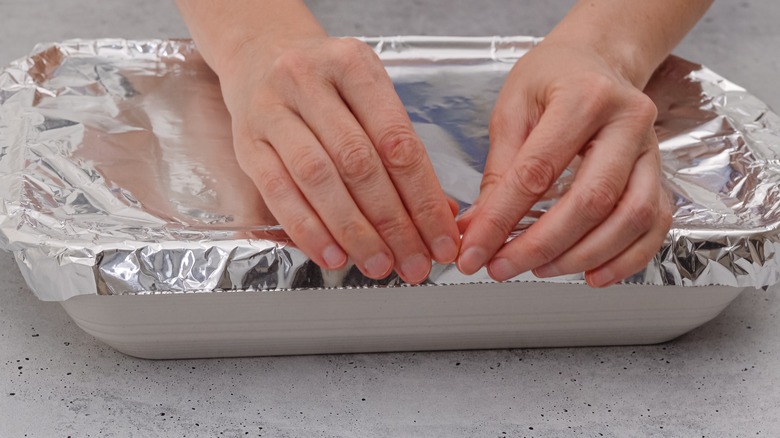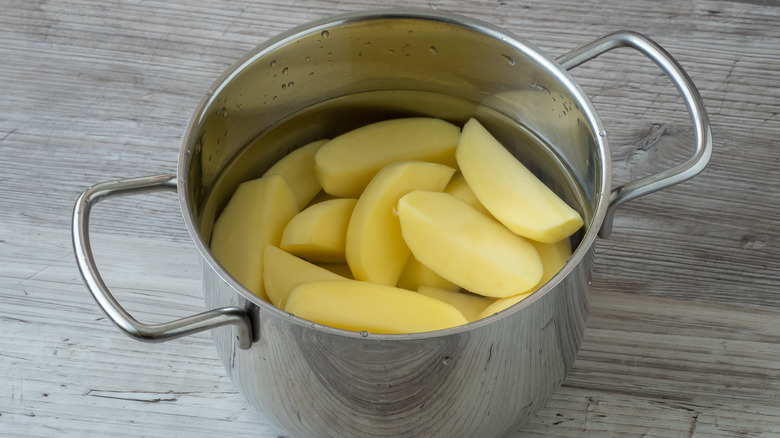What You Didn't Know About Scalloped Potatoes
Scalloped potatoes are clearly a favorite dish of many, as the wealth of online recipes shows. The dish doesn't have many ingredients, the cooking process seems easy enough, and the final result is a creamy, satisfying mix of seasoned carbs and dairy. But this common dish has an unclear past and isn't as simple to make as it first seems. Issues with undercooked potatoes, burnt toppings, curdled milk, and more mean scalloped can be rather frustrating when you first try to make them too.
Solving those problems is possible when you find out more about how the ingredients work together. When you know why a certain ingredient is part of the recipe and what it does when it's mixed with the other ingredients, it becomes a lot easier to figure out how to produce those creamy potatoes that you've been craving. Once you've got your recipe in hand, take a look at what you didn't know about scalloped potatoes.
No one really knows the true origin of the name
Like a lot of recipes, the origin of scalloped potatoes and their name are pretty much lost. There are theories, of course, but it's not known which one is really true. It's possible the "scallop" part of the name derived from a dish of baked oysters covered in bread crumbs, but there's also speculation that "scallop" came from foods baked in scallop shells or foods that looked like scallops. One common definition eventually emerged, in which "scalloped" meant you'd cooked a vegetable in a creamy sauce and added breadcrumbs.
As for where the dish originated, England is often a top contender, although it's also possible scalloped potatoes are a descendant of French au gratin dishes. Regardless of the country of origin, the dish is now a mainstay at both holiday and non-holiday dinners, and it's undergoing yet another evolution as people in the U.S. add cheese.
A lot of you are making potatoes au gratin instead of scalloped potatoes
Lots of recipes for scalloped potatoes contain cheese. However, traditional scalloped potatoes technically don't contain cheese. Potatoes au gratin does contain cheese, and its ingredient list is similar to that of scalloped potatoes. The scalloped version contains thinly sliced potatoes that are covered and baked in a milk- or cream-based sauce, often with onions and seasonings. Potatoes au gratin also contains thinly sliced potatoes layered with cheese and then covered and baked in a cream-based sauce. The term "au gratin" means covered with bread crumbs and/or cheese and crisped, although in the case of potatoes au gratin specifically, the cheese is supposed to be a given. There are regional variations, and every family seems to have its own version of one or both of these recipes. But as far as the traditional recipes are concerned, if you're adding cheese to your scalloped potatoes, other than a little in the topping, you're technically making potatoes au gratin.
However, recipes don't always follow tradition. Adding cheesy layers to scalloped potatoes is popular. It's not unusual to find sites that confuse the two and claim that scalloped potatoes always contain cheese while potatoes au gratin never do. Some sites will even have competing information, with one article saying the opposite of another article. Just keep in mind that if you serve someone cheesy scalloped potatoes, don't be surprised if they call it au gratin.
Potato scallops aren't the same as scalloped potatoes
As we've established, scalloped potatoes are thinly sliced potatoes covered in a dairy-based sauce and then baked. However, if you ever hear someone from Down Under mention potato scallops, they aren't talking about the scalloped potatoes we all know and love in the U.S. The term "potato scallops" refers to an Australian snack consisting of sliced potatoes that are battered and fried, producing a treat with a crunchy shell and soft potato center. They're also called potato cakes and potato fritters in different parts of the country.
Potato scallops in their current sliced form have been around since before the 1930s, although earlier versions used mashed potatoes baked in a scallop-shaped mold. They're often served at fish-and-chip shops, but they're so popular in Australia that even McDonald's has sold them. They sound delicious, but they're certainly not what you'd expect to find if you look up a scalloped potato recipe online.
You need starchy potatoes to make the best version of scalloped potatoes
Scalloped potatoes look like they're just stacks of sliced potatoes covered in sauce, but they're not supposed to taste like stacks of potatoes covered in sauce. The potatoes should soak up as much of the sauce and seasoning as possible so each bite is smooth, rich, and flavorful. Starchy potatoes are key to achieving this mix because the starch cells absorb a lot of liquid, and as the potato heats up, the resulting swelling and steam forces the cells apart. The result is that the potato becomes very fluffy and allows the sauce to be absorbed farther into the potato slices. Russet potatoes are a classic example of a starchy potato.
Waxy potatoes don't break down in the same way. They're great for dishes where they have to stay in a particular shape, but their relatively dense texture doesn't allow sauce to seep in that well. If you use waxy, low-starch potatoes for this dish, the texture may not seem that great. If you don't want to use very starchy Russets, though, there's a group of potatoes that fall in between starchy and waxy. These are known as all-purpose potatoes, and Yukon Golds and white potatoes fall into this group. You'll often find Russets and Yukon Golds listed as examples of what to use in scalloped potatoes.
Divide scalloped potatoes before freezing for more efficient cooking
You can freeze both cooked and uncooked scalloped potatoes, so this a great dish to make ahead for the week or month. But thawing, cooking, and serving the potatoes will be easier if you divide them into smaller portions first. If you freeze a large block of food, it's naturally going to take a long time to thaw. But if you split the food into, say, four portions in four smaller baking dishes, each of those will thaw a lot faster once you're ready to cook them.
There's one other reason why you should divide the potatoes before freezing: portion control. If you freeze an entire dish of potatoes and later want to get some for yourself, you'll have to thaw and then re-freeze the entire thing. That's a lot of time spent just to eat a portion of the dish, and constantly thawing and freezing food can lower its quality, even if it remains safe to eat. If you divide the potatoes, however, then you only have to thaw one portion, leaving the rest fully frozen.
Scalloped potatoes need dairy with a lot of fat in it
You'd think that the type of dairy you use in a recipe wouldn't matter if it were going to be baked into a sauce, but the fat content of the dairy in scalloped potatoes is incredibly important. The less fat you have, the higher the risk that the sauce will curdle while the potatoes are cooking. Curdling occurs when the proteins in the dairy product start to clump together. Fat helps stop that clumping, so if there isn't a lot of fat in the dairy product you use, then you can't really prevent curdling.
If you can't use cream, half-and-half or whole milk should be acceptable. Low-fat and skim milk aren't the best choices, but you can experiment with them if you like. If you want to make vegan scalloped potatoes, check that the dairy substitute you use has at least as much fat as whole milk for better results.
You need only one ingredient to fix runny scalloped potatoes
One of the more common problems with making scalloped potatoes is that the final dish turns out watery or runny. This is a result of either using waxy potatoes or having too much moisture in the dish. If you've stored cut potato slices in water to prevent discoloration (more on that in a bit), pat the potatoes dry and ensure there's no excess moisture left on them as you layer them in the pan. Also double-check that you've got the proportions for sauce and potato correct. Remember, too, that food continues to cook a bit after you've removed it from the oven, and that can help thicken up somewhat thin sauce as you let the potatoes rest for a few minutes.
If you still end up with wet scalloped potatoes, there's one ingredient that will absorb some of the extra moisture. Instant mashed potato flakes will reduce that runny quality. You won't be able to stir the flakes into the entire dish, obviously, but you can add them to areas where you see excess liquid and carefully blend them in. Adding instant mashed potato is an old trick often used to thicken soup, and the flakes should thicken up scalloped potatoes without changing the taste much.
If you consistently end up with hard potatoes, you're not alone
If you've ever taken scalloped potatoes out of the oven, marveling over that bubbling, browned top, only to find that the potatoes were still so crunchy and raw that you wondered if your oven was broken, you're not alone. This usually has to do with the potatoes being too thick to cook through, or with not enough moisture in the dish. You may think you're making thin slices, but for this dish, anything thicker than about 1/8 inch will require extra cooking.
A mandoline is a great option for making those super thin slices (watch your fingertips!). If you don't have a mandoline, you can use a knife, but be sure the potato is stable. Cut a bit off one side to create a flat base that will stop the potato from suddenly scooting to one side as you attempt to cut through. If 1/8-inch potatoes still give you trouble, you may want to check your oven's thermostat and consider pre-cooking your potatoes. Parboiling the potatoes for a few minutes often works.
Go ahead and add meat or vegetables -- just not too much
The cheese controversy aside, it's perfectly fine to add things like a little meat or some vegetables to scalloped potatoes; just don't add too much. The more you add, the more you risk turning the dish into something else, like a casserole. The potatoes and creamy sauce should be the stars of the show, with onions and herbs as supporting players. Any other additions need to be bit players that you notice but don't steal the spotlight.
Potential additions include scallions for extra flavor and breadcrumbs for crunch. Sprinkling a little parmesan on those breadcrumbs (not necessarily in with the potatoes themselves) is another idea, and adding fried onions could give the potatoes a real kick. If you want to add vegetables, thinly sliced carrots and mushrooms are a couple of options. You can add just about anything as long as you don't overwhelm the potatoes.
You might not need to peel the potatoes first
A lot of recipes for scalloped potatoes call for peeling the potatoes, but that might not be necessary if the spuds you use are Yukon Gold. Those have a very thin peel that's light in color; the peel softens easily during cooking and blends in well with the rest of the potatoes and toppings. You could get away with just scrubbing the peel well to ensure it's completely clean.
Russet peels are thicker and tougher, however, and they'd be very visible in scalloped potatoes. These peels would change the texture of the dish because they wouldn't be soft enough to let your teeth sink through them easily, and you'd end up with globs of chewy peel among the soft potatoes and sauce. You really will want to peel Russets. By the way, remember to wash the potatoes before peeling. Potato peels can hold bacteria like Clostridium botulinum, which causes botulism. When you cut into the potato, the knife can carry germs through the peel.
Cover scalloped potatoes in foil when cooking
In a perfect world and in a perfect oven, scalloped potatoes would cook thoroughly without having cold spots or burnt tops. Chances are you don't live in that perfect world and don't have a perfect oven, so you need some scalloped potato tricks to ensure the potatoes end up with just the right amount of browning while still being cooked all the way through.
Chef Michael Symon uses aluminum foil to protect the tops of the potatoes from burning, much like you'd cover a pie crust to prevent it from burning as the pie's filling cooks. If you want the top to have a nicely browned appearance, remove the foil about two-thirds of the way through the cooking time. Keep an eye on the dish during that last third, though; if the top becomes too dark, put the foil back on for the rest of the cooking time.
Cover the potato slices with water -- but don't soak them overnight
Raw potatoes change color when you let them sit out after cutting or peeling them. This happens when an enzyme called polyphenol oxidase (PPO) comes into contact with oxygen, and the resulting reaction puts phenolic compounds in the potato through a series of conversions until they eventually become pigments. Those pigments show up as a gray, purple, brown, or black color and aren't dangerous, but they don't look great, either. Covering the potatoes in water helps slow oxidation by forming a barrier between the potato and air (but it doesn't stop the process), and adding an acid like lemon juice to the water slows it down further. By the way, blanching also helps stop oxidation, but it adversely affects the nutritional content of the potatoes.
What all that has to do with scalloped potatoes is that, if you want to slice potatoes ahead of time and store them in water, don't store them that way for long. Remember the previous section about using thin slices to avoid having to pre-cook the potatoes? If the slices are thin enough, they'll disintegrate if left in water for too long. And that soaking will remove some of the starch from those potatoes, increasing the risk that the finished dish will be runny. You can still slice the potatoes ahead of the actual layering and cooking time, but don't do it too early, and definitely don't try it the day before.
